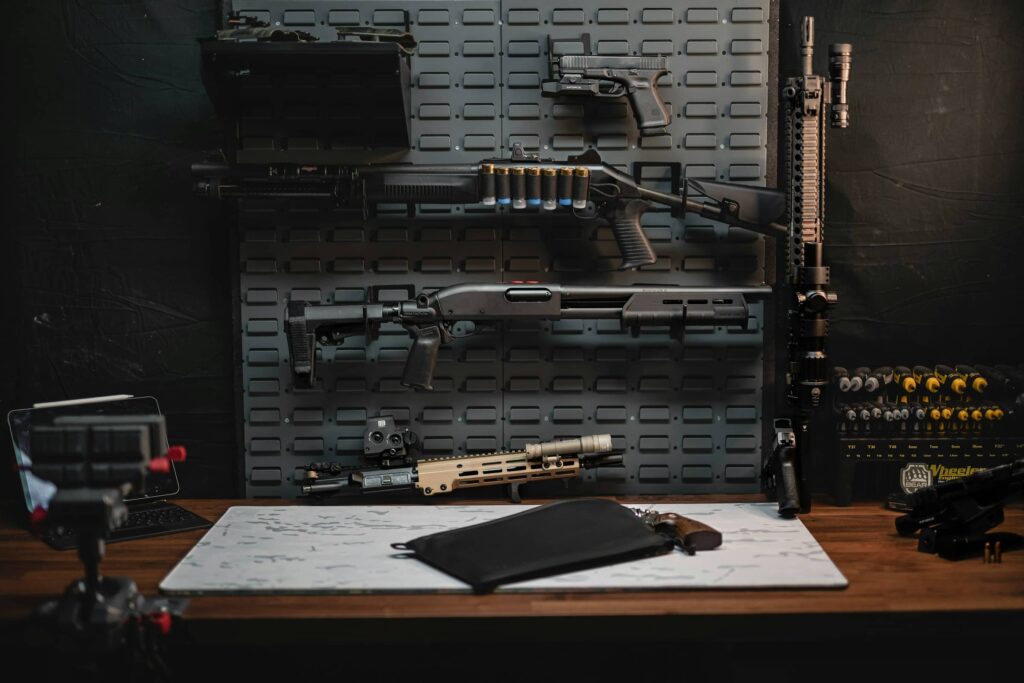Want to get a suppressor without the headache? Contrary to popular belief, the process is straightforward with the right guidance. While federal regulations and paperwork might seem daunting, responsible firearm owners can successfully navigate the legal requirements by understanding the application process, state-specific regulations, and key compliance steps. This blog will outline the steps you need to take to get your first suppressor.
Table of Contents
Understanding the Basics of Suppressor Ownership
Suppressors, often referred to as silencers, are legal in 42 states across the United States. Their ownership does not require a special license or permit, making them accessible to law-abiding citizens who follow the necessary federal procedures. These devices are not only legal but are also widely used for both recreational shooting and hunting in most states.
Certain states, however, do not permit the ownership of suppressors. These states include California, Delaware, Hawaii, Illinois, Massachusetts, New Jersey, New York, and Rhode Island. The District of Columbia also prohibits civilian ownership of suppressors. Residents in these areas must adhere to local laws and should be aware of their inability to legally own such devices.
States where suppressors are illegal:
- California
- Delaware
- Hawaii
- Illinois
- Massachusetts
- New Jersey
- New York
- Rhode Island
In states where suppressors are legal, they offer significant advantages. These include reducing noise pollution and providing hearing protection, which enhances shooting experiences and safety. Suppressors also improve accuracy by mitigating recoil. For hunters and shooting enthusiasts, these benefits make suppressors a valuable tool in responsible firearm use.
The Application Process for Suppressor Acquisition

Purchasing a suppressor in the United States requires obtaining a tax stamp from the federal government. The cost of the tax stamp is $200, which is a mandatory fee added to the suppressor purchase. This process involves submitting an ATF Form 4, which is crucial for the legal transfer and registration of the suppressor. Despite the upfront cost, acquiring a suppressor can be a straightforward process.
Electronic Filing Process
The ATF’s eForm 4 process allows for electronic submission, which can significantly reduce approval times compared to traditional mail. To file electronically, individuals need to create an account on the ATF’s eForms website. Once registered, applicants can fill out the digital Form 4, attach necessary documents, and pay the tax stamp fee online. The electronic method streamlines the process and is a preferred option for many due to its efficiency.
Necessary Documentation
To complete the application, several key pieces of documentation are required. Fingerprinting is mandatory, and applicants can accomplish this at authorized locations or by using a kiosk that captures all ten fingerprints. It’s essential that prints are clear to prevent delays. A passport-style photo is also needed, which should be recent and taken with a light-colored background, without hats or glasses. These documents, along with personal identification information, must be uploaded with the eForm 4 submission.
Once the application is submitted, processing times can vary. Currently, applicants can expect wait times ranging from 6 to 11 months. However, using the eForm 4 can potentially expedite the process (I’ve seen people get approved within a week recently). Ensuring all documentation is complete and accurate is crucial to avoid unnecessary delays. Additionally, some applicants choose to set up a trust, which can make the process smoother and provide flexibility in ownership transfer.
Navigating Suppressor Regulations by State
Understanding the regional regulations for suppressor ownership is essential for any firearm enthusiast or hunter. Each state has its own set of rules and requirements, which must be followed to ensure legal compliance. Familiarizing oneself with these laws can prevent legal issues and ensure a smooth purchasing process.
| State | Licensing Requirements |
|---|---|
| Michigan | No specific permit, but federal compliance required |
| Florida | No state permit, follow federal guidelines |
| Texas | No state permit, federal compliance only |
| California | Suppressor ownership prohibited |
| New York | Suppressor ownership prohibited |
Michigan Suppressor Permit
In Michigan, while there is no specific state permit needed for suppressor ownership, individuals must comply with federal regulations, including obtaining a tax stamp through the ATF. The process involves submitting ATF Form 4 and adhering to all federal requirements.
Florida Suppressor Laws
Florida does not require a state-specific permit for suppressors. However, residents must follow federal procedures, including the purchase of a $200 tax stamp. This ensures that ownership and use of suppressors are in compliance with federal law.
Texas Suppressor Licensing
Texas does not impose additional state licensing requirements for suppressor ownership. Interested parties must meet federal standards, including completing the necessary ATF paperwork and acquiring a tax stamp. This aligns Texas with federal laws, making the process straightforward for residents.
While Texas generally follows federal regulations for suppressor ownership, a new law (HB 957) passed in 2021 exempts suppressors manufactured and remaining in Texas from federal regulation. However, this state law conflicts with federal law, which still requires compliance with federal regulations for all suppressors6. It’s important to note that federal law typically supersedes state law in such cases, and individuals should be cautious about relying solely on the state exemption.
Choosing and Maintaining Your Suppressor

When selecting a suppressor, there are several crucial factors to consider to ensure it meets your needs. The primary considerations is firearm compatibility.
A suppressor must be matched with the proper caliber and firearm type to function correctly. A rule of thumb is you can shoot whatever you want through a given suppressor as long as the bullet is smaller than the opening on the suppressor. Obviously, if you shoot a .50 cal through a .22 lr suppressor you are going to be in trouble.
Cost is another important factor, as suppressors can vary significantly in price based on brand, materials, and features. Reputable dealers and manufacturers can provide guidance and support, helping you make an informed decision.
- Compatibility: Ensure the suppressor fits the firearm’s caliber and model.
- Manufacturer Reputation: Choose a manufacturer with a good track record and customer reviews.
- Material and Design: Consider durability and weight, which affect handling and performance.
- Cost: Assess your budget and look for suppressors that offer good value for money.
- Warranty and Support: Look for products with solid warranties and manufacturer support.
Cleaning
- High-pressure cartridge suppressors: These generally don’t require cleaning as the heat from the bullet burns away most residue.
- Rimfire and pistol-caliber suppressors: These typically need more frequent cleaning.
- For rimfire suppressors, disassemble and clean after every 500 rounds fired.
- Use a cotton swab or threaded cotton swab to wipe down the interior.
- User-serviceable suppressors: These can be disassembled for thorough cleaning.
Maintenance Tips
- Clean the mount interface of the silencer and muzzle device after every use to prevent the suppressor from getting stuck.
- For QD attachments, clean the muzzle device after each outing.
- Use safe cleaning agents like CLP, Hoppes #9, or acetone. Avoid abrasive solvents.
- Use a nylon brush for cleaning, especially on aluminum parts.
- Check O-rings in piston systems and replace if damaged.
Special Considerations
- For sealed suppressors, minimal cleaning is needed. Consult the manufacturer if unsure.
- Some suppressors, like those used with .300 AAC Blackout, may benefit from occasional high-pressure rounds to burn away deposits.
Remember, always follow the specific instructions provided by your suppressor’s manufacturer for optimal maintenance and longevity.
Exploring the Benefits of Suppressor Ownership
Suppressors provide substantial noise reduction, which is one of their primary benefits. By significantly lowering the sound of gunfire, suppressors make shooting more enjoyable and protect hearing. Firearm users can shoot comfortably without the need for additional ear protection, enhancing their overall experience. This reduction in noise also minimizes the impact on surrounding wildlife and communities, making suppressors a preferred choice for hunters and recreational shooters.
- Compatibility: Suppressors can be used on a wide range of firearms, from handguns to rifles, allowing versatility.
- Recoil Reduction: By dampening the force of the shot, suppressors help reduce recoil, making firearms easier to control.
- Accuracy Improvement: With less recoil and noise, shooters can maintain better focus and stability, often leading to improved accuracy.
- Safety Enhancement: Lower noise levels contribute to safer shooting environments, where communication remains clear.
For both casual shooters and hunters, owning a suppressor offers numerous advantages. The ability to shoot without disturbing others and the potential for improved marksmanship make suppressors a valuable addition to any firearm collection. These benefits align with the principles of responsible gun ownership and enhance the overall shooting experience.
Final Words
Navigating the intricacies of suppressor ownership requires understanding varying state laws and the application process. Acquiring a suppressor involves multiple steps, including obtaining a tax stamp and adhering to documentation requirements. Regional regulations, such as those in Michigan, Florida, and Texas, can impact ownership rules.
Choosing the right suppressor and maintaining it properly are crucial for optimal performance. The advantages of owning a suppressor, from noise reduction to improved shooting accuracy, make them appealing for many firearm users.
By knowing how to get a suppressor and keeping informed, enthusiasts can enjoy safer and more enjoyable shooting experiences.
FAQ
Is it hard to get approved for a suppressor?
Getting approved for a suppressor requires completing the ATF Form 4, paying a $200 tax stamp, and submitting fingerprints and a photo. Approval times range from 6 to 11 months but continue to decrease.
What disqualifies you from owning a suppressor?
Disqualifications for owning a suppressor include being a felon, having a restraining order, or being dishonorably discharged from the military. Mental health issues or substance abuse can also disqualify applicants.
Which states are suppressors illegal?
Suppressors are illegal in California, Delaware, Hawaii, Illinois, Massachusetts, New York, New Jersey, Rhode Island, and Washington, D.C.
What paperwork do you need for a silencer?
To acquire a silencer, you need the ATF Form 4, a $200 tax payment for the stamp, fingerprint cards, and a passport-style photo. These must be submitted for approval.
- The Right Gear for Upland Hunting - December 21, 2024
- How to Get a Suppressor in a Few Steps - December 5, 2024
- What is The Protection of Lawful Commerce in Arms Act? - November 15, 2024




